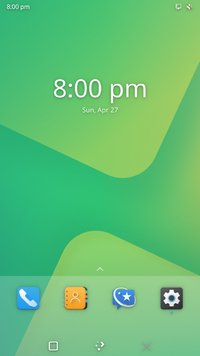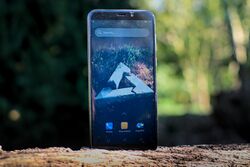Plasma Mobile
 Plasma Mobile homescreen. | |
| Name | Plasma Mobile |
|---|---|
| Graphics stack | KWin on Wayland |
| Toolkit | Qt 6 |
| In postmarketOS | |
| Package | postmarketos-ui-plasma-mobile |
| Status | Available |
A mobile variant of the KDE Plasma user interface, optimized for touchscreen.
Installation
| This user interface recommends systemd Using OpenRC instead of systemd might or might not work |
Use the pre-built images from the downloads section of postmarketos.org, or build your own image with pmbootstrap. If using the latter, Plasma Mobile can be installed by selecting it as the UI in pmbootstrap init.
On existing systems, it can be installed by installing the postmarketos-ui-plasma-mobile meta package or plasma-mobile if postmarketOS specific customization is not wanted.
When running pmbootstrap install you'll be prompted for a user password. On an existing Plasma Mobile install you can change your user password and PIN in the Terminal with the standard passwd command.

Usage
First Boot
| If you get stuck, head over to Matrix and IRC chats. Report issues. |
As with all other interfaces in postmarketOS, the first boot takes longer than usual: the file system will be resized to use the entire device.
After boot, you are asked for your PIN. For pre-built images, this is 147147. If you flash a rootfs
created with pmbootstrap, the "PIN" is the user password you provided during pmbootstrap install.
Connect to Wi-Fi
Swipe the top bar down to reveal a menu with a Wi-Fi symbol. Tapping the symbol itself will turn Wi-Fi on or off. To connect to a network the first time, hold down the Wi-Fi quick setting to open the settings application. Now select an access point.
Install Updates
Go to the Home Screen (tap the bottom right X if you have an application open). Swipe from the bottom upwards to reveal the app menu and start Discover, KDE's graphical package manager frontend. When Discover asks for privileges (pmaports#1036), type in your user's PIN (e.g. 147147 for pre-built images), or click entry field to open keyboard and type non-numeric user PASSWORD as given during pmbootstrap install.
Swipe from the left to center to open Discover's menu, and select the entry with the up-arrow at the very bottom (it may say "Fetching updates" or the number of updates available). From here you can perform the updates. Depending on what has been updated, you need to reboot the device afterwards for changes to take effect.
Running Apps from SSH session
In order to run applications on the device, you need to set up your environment similar to the environment in which the plasmashell is running:
export $(cat /proc/$(pidof plasmashell)/environ | tr '\0' '\n')
For the official KDE instructions on running Plasma Mobile, see https://develop.kde.org/docs/plasma-mobile/running-apps/.
Taking screenshots
Screenshots can be taken by pressing the quick setting for it in the top drawer.
You can however also do it with the command line with spectacle installed:
spectacle -b
Power Off and Reboot
Hold the power button for about three seconds, then let go. Do not hold it too long, or else you will force-reboot your device. You will be presented with the options to reboot, power off or cancel. plasma-phone#71 is about making this a bit more intuitive.
Configuration
Keyboard shortcuts
The settings windows can be called by commands kcmshell6 kcm_keys and kcmshell6 khotkeys. The first one is for Application Shortcuts and the second brings up Custom Shortcuts. [This method seems to be deprecated as of 19-01-2025]
Disabling double tap to wake
Until the proximity sensor functionality is integrated into Plasma, the "double tap to wake" feature, on the phone screens that support it, tend to wake the phone in the pockets of users, or even by picking it up as it is very sensitive/permissive. To disable the feature, one can edit the ~/.config/kwinrc file to add under the [Wayland] group, the line
DoubleTapWakeup=false
Physical keyboard layout
The physical keyboard layout can be changed be creating ~/.config/kxkbrc with the following content:
[Layout]
LayoutList=de
Use=true
Replace de in the LayoutList with your keyboard's language code. All available keyboard layouts should be in /usr/share/X11/xkb/symbols/. This still applies to Wayland, even if they come from X11.
Nightly repository
postmarketOS has a nightly repository which contains (semi-) nightly builds of all KDE packages to make it easy to develop Plasma Mobile and its applications on postmarketOS which are currently built against Qt6.
More info can be found at Nightly.
Troubleshooting
Desktop lock screen
When you get the desktop lock screen instead of the mobile version and no virtual keyboard opens such that you are unable to login, check if you have ui_extras enabled in ~/.config/pmbootstrap.cfg. If yes, disable it and rebuild / reflash the image. This issue may occur in combination with the #Nightly repository.
Scaling
On devices such as the Samsung_Galaxy_A5_2015_(samsung-a5ulte), Samsung_Galaxy_A3_2015_(samsung-a3), BQ Aquaris X5 (bq-paella) or Moto_G4_Play_(motorola-harpia), you may need to set a custom scaling factor.
The following sets a 2x scale factor (fractional factors are possible):
kscreen-doctor output.1.scale.2
If you're trying to run this from SSH session, you need to set extra env vars:
XDG_RUNTIME_DIR=/run/user/10000 QT_QPA_PLATFORM=wayland kscreen-doctor output.1.scale.2
To persist this zoom setting across reboots, create a new file "set-plasma-zoom.desktop" in ~/.config/autostart/ with the following contents:
[Desktop Entry]
Exec=/usr/bin/kscreen-doctor output.1.scale.2
Name=Set zoom level
Terminal=False
Type=Application
Log output
Logs are written to ~/.local/state/tinydm.log.
Logging isn't verbose
One needs to enable debug logging for certain components in ~/.config/QtProject/qtlogging.ini. Without that, you barely see any log output. We ship such a qtlogging.ini file in postmarketos-ui-plasma-mobile because Plasma Mobile is relatively new and we want to be able to debug it properly.
If the file did not get installed for you, please double check if it is there and report in #1038.
KWin doesn't work
| Plasma Mobile shell uses some Wayland protocols, so you can't run it on X11 in case you tried to do that. |
Please follow these instructions for debugging.
Some env vars that may help Angelfish browser
# Recommended in https://bugreports.qt.io/browse/QTBUG-80665
export QTWEBENGINE_DISABLE_GPU_THREAD=1
# Flags are based on workaround for SFOS (disable-gpu-compositing) and default Android settings:
# Multiple Raster Threads: Disabled
# Flags enabled by Qt if enable-embedded-switches is given
export QTWEBENGINE_CHROMIUM_FLAGS="--disable-gpu-compositing --num-raster-threads=1 --enable-viewport --disable-composited-antialiasing"
( source )
Starting Plasma Mobile from the Terminal
If postmarketos-ui-plasma-mobile is installed, Plasma Mobile will be automatically launched via tinydm.
It can also be launched manually by running the following script:
#!/bin/sh
export QML2_IMPORT_PATH=/usr/lib/qt/qml:/usr/lib/qt5/qml
export QT_QPA_PLATFORMTHEME=KDE
export QT_QUICK_CONTROLS_STYLE=Plasma
export QT_WAYLAND_DISABLE_WINDOWDECORATION=1
export XDG_CURRENT_DESKTOP=KDE
export KDE_SESSION_VERSION=5
export PLASMA_PLATFORM=phone:handset
export QT_VIRTUALKEYBOARD_STYLE=Plasma
export QT_QUICK_CONTROLS_MOBILE=true
export QT_ENABLE_GLYPH_CACHE_WORKAROUND=1
sleep 2
if [ -d "/dev/dri" ]; then
kwin_wayland --drm --xwayland plasma-phone 2>&1 | logger -t "$(whoami):plasma-mobile"
else
# NOTE: using GALLIUM_DRIVER=llvmpipe might give you better performance (or not work at all.)
# see: https://gitlab.postmarketos.org/postmarketOS/pmaports/-/issues/852
export GALLIUM_DRIVER=softpipe
export KWIN_COMPOSE=Q
export LIBGL_ALWAYS_SOFTWARE=1
echo "startplasmamobile: using software rendering with: ${GALLIUM_DRIVER}" | logger -t "$(whoami):plasma-mobile"
kwin_wayland --framebuffer --xwayland plasma-phone 2>&1 | logger -t "$(whoami):plasma-mobile"
fi
WiFi does not autoconnect
There's an unfortunate bug that makes re-connecting to WiFi require tapping the network again each time. This comment in the bug thread explains a work around to connect to networks automatically.